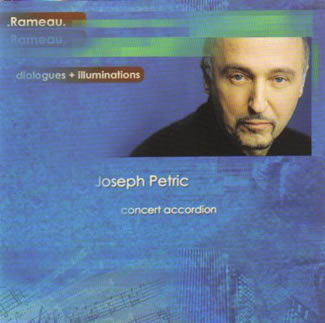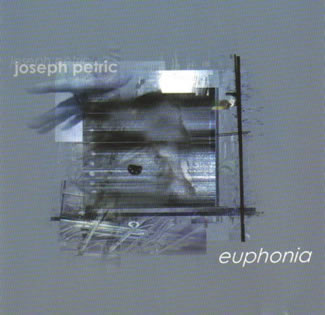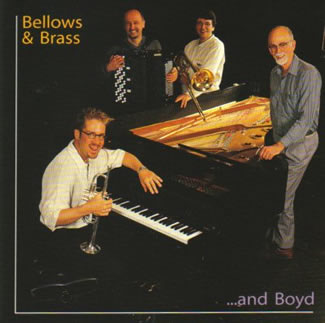The Free-Reed Review
Critiques of Compact Discs, Books and Music
Scores
CD Review: Three New Titles by Joseph Petric
 Joseph Petric, Concert Accordion
Joseph Petric, Concert Accordion
Released: 2005
Label: Air Records
Total Time: 72:05
|
Rameau: Dialogues and Illuminations
Selections
- Prelude
- Le Rappel des Oiseaux
- Gigue en Rondeau
- 2ieme Gigue en Rondeau
- La Villageoise
- Musette en Rondeau
- Tambourin
- La Dauphine
- La Poule
- L'Enharmonique
- L'Egyptienne
- Les Indes Galantes
- Marche des Persans
- Les Sauvages
- L'Entretien des Muses
- Les Niais de Sologne
- 1er Double des Niais
- 2d Double des Niais
- Les Soupirs
- Les Tourbillons
- Les Cyclop
|
Reviews by Henry Doktorski:
Rameau's keyboard works were written for the 18th century French harpsichords, an instrument of great power and resonance. They were notable for their resonant bass, luminosity of pitch, a cantabile upper register and stops which provided flexibility and softness.
This recording by Canadian Concert Accordionist Joseph Petric presents collections of Rameau from 1706 to 1747 while respecting of historical attitudes toward French keyboard music publication and performance as they were understood in the 17th and 18th century. This was an era when composers created materials grouped by key or genre; performers then made up their own performance collections or suites, breaking with, or acknowledging tradition in their desire to transport audiences by moving them to laughter, reflection or wonder.
Rameau's Premiere Livre of 1706 begins with an unmeasured prelude, followed by a two part allegro which reveals homage to the lute-based preludes of an earlier era. But there are also works in this collection that reveal a cantabile bass or gigue melody hinting at Rameau's new imagination.
In Mussette en Rondeau Rameau reveals bucolic bagpipes; in Le Rappel des Oiseaux he unleashes a veritable army of chirping responsorials; in 1iere Gigue and 2ieme Gigue en Rondeau, subtle and dreamy melodic and agogic writing is followed by the suave melodic writing and unprecedented bass line of La Villagoise and the irrepressible Tambourin.
Les Sauvages was inspired by two Louisianna aboriginals whose dancing was characterized after Rameau saw their performance at the Theatre Italien in Paris September 10 1725.
Les Tourbillons, a work of extreme virtuosity, is written in such a way that physical and musical exaggeration is not possible. Le Cyclops is unprecedented in the French keyboard repertoire on account of its extreme virtuosity. It is a fitting way to end the recital.
Although this recording is far different in sound than the more familiar harpsichord versions, the free-bass accordion provides a musically-fulfilling version of these Rameau pieces. My kudos to Joseph Petric. I highly recommend this CD for all Classical Accordion Lovers.
 Joseph Petric, Concert Accordion
Joseph Petric, Concert Accordion
Released: 2005
Label: Air Records
Total Time: 71:19
|
Euphonia - Solo works by women composers
Selections
- Klucevsek's Web - Janika Vandervelde (1955 - ....)
- Seriosity - Rose Bolton ( 1971 - .....)
- Sonata for Accordion - Rose Bolton (1971 -....)
- Fondly, through the madness - Micheline Roi (1963 -....)
- Curvilinear - Jocelyn Morlock (1969 - ....)
- Low Tide - Linda C. Smith - (1967 - ....)
2006 Jules
Leger Prize Winner
|
This album features original works for accordion written by Canadian women composers. The title of the album, "Euphonia," is a Greek word which means "well sounded, with ease of pronunciation, pleasing."
I found this to be an interesting, and yes, pleasing, album to listen to. Certainly this music is not what is normally heard on the accordion, but the sounds will be familiar to contemporary music aficionados--those classical music lovers who enjoy the journey to less-familiar territories, abandoning tonality and metric regularity to experience an intellectually-stimulating recital.
 Joseph Petric, accordion
Joseph Petric, accordion
Guy Few, trumpet and piano
Alain Trudel, trombone
All music composed by Boyd McDonald.
Label: Springdale Records
Released: 2001
Total Time: 66:44
|
Bellows and Brass and Boyd
Selections
- Tango (trumpet, piano, accordion, trombone)
- Pulsations for Piano
- Three Accords (for solo accordion)
- An Artist's Neighbourhood (solo piano)
- Concertpiece for Trumpet and Piano
- Overture for Accordion and Piano
- Three for Two (trumpet, trombone, piano)
- Time Lines for Piano Four Hands
|
Boyd McDonald began his career as a pianist giving his Wigmore Hall debut in 1960 followed by a New York Debut in 1963 as winner of the Leschetizky Town Hall Debut Prize.
He toured North America, Europe and England as a member of the Beckett and McDonald Piano Duo. Since 1982 he has been an active fortepianist recording the Complete Works for Cello and Fortepiano by Beethoven with Paul Pulford. As an academic he taught composition at the University of Manitoba. He joined the Faculty of Music at Wilfrid Laurier University in 1976 where he currently teaches piano as Professor Emeritus.
As a composer McDonald studied with Murray Adaskin, three years with Nadia Boulanger on a Canada Council grant and summer schools with Darius Milhaud, John Cage and Stefan Wolpe. His works display a synthesis of virtuosity combined with a theatricality valued by performers whose concerts must be seen as well as heard.
This album will be warmly received by Classical Accordion Lovers for the three tracks which feature accordion: Tango, Three Accords and Overture for Accordion and Piano.
About Joseph Petric
Joseph Petric was born in Acton, Ontario, Canada. He was taken to his first accordion lesson with a local teacher by his father at age 5, an experience that influenced the course of his life. He studied informally until the age of 17 then enrolled at the Royal Conservatory of Music in Toronto. In 1970 he began a Bachelor of Music degree program at Queen's University, and completed a Master of Arts Degree in Musicology with Dr. Rika Maniates at the University of Toronto in 1977.
"Pivotal to my artistic development was the opportunity to hear Hugo Noth play adaptations of Scarlatti, Bach and Rameau as well as contemporary works...it was a defining moment ..."
In 1977 he moved to Europe to study with Noth. That same year he began his decade long correspondance with John Cage and David Tudor, his long association with luthier Leo Niemi, and premiered the first of his 194 commissions.
"having played the piano accordion until then, it became clear to me that it had interpretive deficiencies ... I assumed the chromatic C system button 9 row left hand combination system ...based on Franco Vercelli's 1904 attestation of the classical concert accordion.."
After quickly mastering the button accordion in 3 months, Petric devoted his time to the study of anatomy, neurological function, acoustics, instrumental technique and construction. A winner in the CBC National Radio Auditions, he recorded frequently for CBC national radio and many of Canada's finest new music ensembles including New Music Concerts, the Vancouver New Music Society and Le Societe de Musique Contemporaine de Quebec. Petric's interest in the intimate process of adaptation in the postmodern led him to study Baroque and Pre-Classical repertoire, instruments and style with the renowned harpsichordist Colin Tilney (1996-2001) and Leslie Huggett (1989-1993). He pursued his interest in improvisation with Pauline Oliveros in New York (1989-1994). In 1986 he was invited to work with the Canadian Electronic Ensemble, an experience which led him to commission 26 works for live electronics and multi media from the Canadian electro-acoustic community.
 Joseph Petric, Concert Accordion
Joseph Petric, Concert Accordion Joseph Petric, Concert Accordion
Joseph Petric, Concert Accordion Joseph Petric, accordion
Joseph Petric, accordion